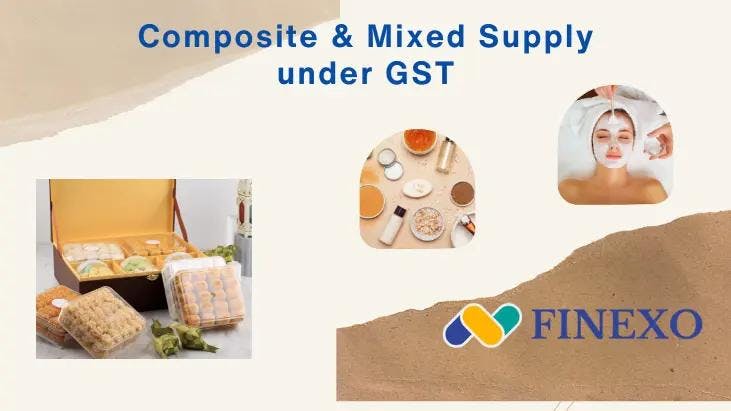
Composite and Mixed Supply under gst
GST is a supply-based tax whether it is a supply of goods or services. The government has separately defined rate of tax applicable for supply of goods or services based on the category which they belong.
So, classification of goods is essential in identifying the applicable rate. But not all supplies can be classified easily. Because some of them are combinations of both goods and services. So, it is difficult to identify the rate of tax.
To overcome this hardship GST law has defined composite and mixed supplies. So let us discuss these concepts and difference between them-
COMPOSITE SUPPLY
What is composite supply?
A composite supply consists of two or more taxable supplies of goods or services or both or any combination thereof. Such supplies are naturally bundled and supplied together in the ordinary course of business. One of which is a principal supply.
For clarity let see examples-
- When a consumer buys a television set and he also gets a warranty and a maintenance contract with the TV, this supply is a composite supply. In this example, supply of TV is the principal supply, warranty and maintenance services are ancillary.
- A hotel provides breakfast along with accommodation as a package deal. This is a natural bundling of service, and it is not possible to separate them.
How to determine composite supply
A supply of goods and/or services is considered as composite supply if following criteria is fulfilled-
- Supply involves two or more goods or services together.
- Supply is naturally bundled
- The nature of service is that one is the main service and others are incidental services.
- They usually come in bundles and cannot be purchased separately.
- They usually advertised as a package.
- If consumers generally expect such services to be provided as package, then such package can be treated as naturally bundled in ordinary course of business.
Tax rate in case of composite supply-
The tax rate of principal supply will apply on entire supply.
Example- A 5-star hotel in Mumbai provides a 4 days and 3 nights package with breakfast. This is a composite supply as the package of accommodation facilities and breakfast is a natural combination in the ordinary course of business for a hotel. In the case, Hotel accommodation is the principal supply and breakfast is ancillary to hotel accommodation. If hotel accommodation attracts 18% tax and restaurant service attracts 5%. Then entire supply will be taxed at 18%.Time of supply in case of composite supply-
If the principal supply is a service (like transport) then composite supply will be treated as supply of service. Then the provision related to the time of supply of service will be applicable.
Similarly in the case of purchasing and transporting goods then supply of goods is principal supply. Then the provision related to the time of supply of goods will be applicable.
MIXED SUPPLY
What is a mixed supply?
A mixed supply is two or more independent products or services which are offered together as a bundle but can also be sold separately. To understand this clearly let see examples-
- A Diwali gift box consisting of canned foods, sweets, chocolates, cakes, dry fruits and juices supplied for a single price is a mixed supply. Because these items can be sold separately and are not dependent on each other.
- A plant nursery sells cut flowers, ornamental plants, and gardening services together as a bundle, but these can be sold separately. So, this is a mixed supply.
How to determine mixed supply?
A supply of goods and/or services is considered as mixed supply if following criteria is fulfilled-
- In order to identify if the particular supply is a mixed supply, the first requisite is to rule out that the supply is a composite supply.
- A supply can be a mixed supply only if it is not a composite supply. It means these are not naturally bundled in ordinary course of business.
Tax rate in case of mixed supply-
A mixed supply comprising of two or more supplies shall be treated as a supply of that particular supply that attracts the highest rate of tax.
Example-A gift pack has following items with respective tax rates-
In this case dry fruits attracts highest rate of tax in the mixed supply I.e. 18%. Hence, the mixed supply will be taxed at 18%.Time of supply in case of mixed supply-
If the highest rate of tax belongs to a service, then the time of supply of service is taken as the applicable time.
Similarly, if the highest rate of tax belongs to goods, then the time of supply of goods is taken as the applicable time.
Difference between composite and mixed supply-
At first instance both types of supply look very similar to each other. In both cases we talk about supplying goods and services as a bundle for a single price. Then how to differentiate between these two. Let us have a look-
Let see some clarifications and circulars-
- Transportation services provided by GTA- If any secondary services like packing/unpacking, transshipment, warehousing are provided in relation to transportation of goods by road and charges for such services are included in invoice issued by GTA then such services would form part of GTA service and it will be treated as a composite supply( not a separate supply.)However if it is charged separately then it would be treated as a separate supply.
- Taxability of printing contracts- printing contracts are composite supplies. In the case of printing books, pamphlets, brochures, annual reports, where only content is supplied by the publisher while the physical inputs like paper used for printing belong to the printer, then supply of printing is the principal supply. In case of supply of printed envelops, letter cards, printed boxes, tissues, napkins etc. Printed with design, logo etc. Supplied by the receiver of goods but made using physical inputs including paper belong to the printer, then the principal supply is of goods.
- Supply of books- The supply of books shall be treated as a supply of goods as long as the supplier owns the books and has the legal rights to sell those books on his own account.
- Servicing of cars including spare parts and services- The taxability of supply would have to be determined on a case-to-case basis looking at the facts and circumstances of each case. Where a supply involves both goods and services and the value of such goods and services supplied are shown separately, goods and services would be liable to tax at the rates as applicable to such goods and services separately.
- Buy one get one free- Sometime companies announce offers like Buy one get one free like buy one shirt and get one shirt free. Generally, GST law defines that goods or services which are supplied without consideration would not be treated as supply. But it is not a case of individual supply of goods, it is a case of two or more supplies where a single price is charged. So, the taxability of these supplies will depend on whether it is a composite supply or a mixed supply of goods.
Conclusion
So, to conclude we can say that the concept of composite and mixed supplies is crucial in GST as it helps in determining the taxability of a transaction. A proper understanding of these concepts is essential for businesses to ensure that they are fulfilling the compliances correctly with GST laws.
About CA Shravagi Jain
CA Shravagi Jain has completed her CA in 2021. She is engaged in writing articles and also teaching CA students.
